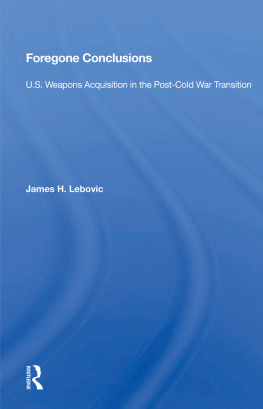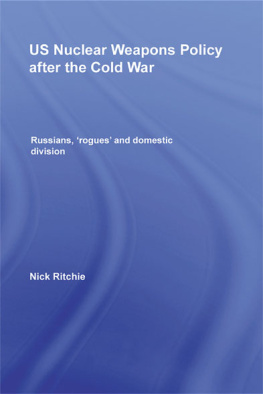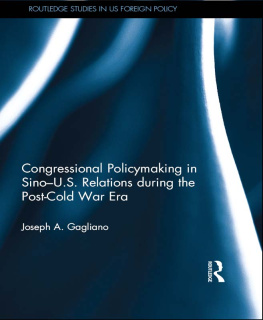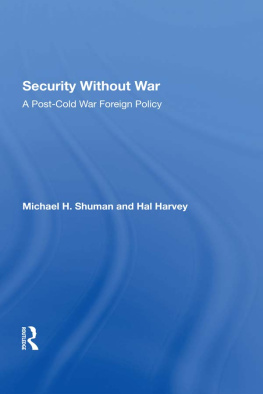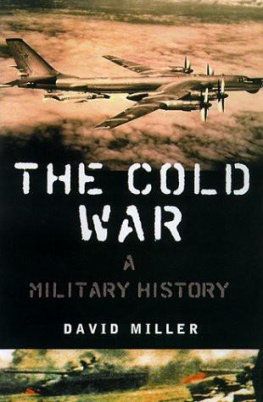For Holly
First published 1996 by Westview Press
Published 2018 by Routledge
52 Vanderbilt Avenue, New York, NY 10017
2 Park Square, Milton Park, Abingdon, Oxon OX14 4RN
Routledge is an imprint of the Taylor & Francis Group, an informa business
Copyright 1996 by Taylor & Francis
All rights reserved. No part of this book may be reprinted or reproduced or utilised in any form or by any electronic, mechanical, or other means, now known or hereafter invented, including photocopying and recording, or in any information storage or retrieval system, without permission in writing from the publishers.
Notice:
Product or corporate names may be trademarks or registered trademarks, and are used only for identification and explanation without intent to infringe.
A CIP catalog record for this book is available from the Library of Congress
ISBN 13: 978-0-367-01492-6 (hbk)
I am grateful to Dave Auerswald, Deborah Avant, Matt Evangelista, Forrest Maltzman (and thus Sarah Binder), Henry Nau, Ed Rhodes, Jeff Richelson, Susan Sell, Lee Sigelman, Bob Stoker, and Chris Tillery for their suggestions or comments on various chapter or manuscript drafts. I especially appreciate the contribution of two people my informal technical advisor, Jack Hicks, for being too easily cornered at social gatherings and Dwayne Day, for enthusiastically generating useful research materials. I further appreciate the early support of the Graduate School of Arts and Sciences at The George Washington University through a Dilthey Research Award. I also wish to thank Jennifer Knerr and Brenda Hadenfeldt of Westview Press for their editorial help and Paul Richard for his useful substantive comments. Of course, I alone assume responsibility for the argument and any deficiencies in this book.
U.S. Weapons Acquisition in the Post-Cold War Transition
Uncertain about the future and lacking direction, the United States faces a rapidly changing security environment. The U.S. defense community has traditionally dealt with change by offering more of the same: trimming and deferring some programs, cancelling others, while offering a budget essentially like those before it. With the end of the Cold War, it continued the practice. The U.S. downsized and restructured military forces without profoundly rethinking U.S. global strategy and tactics or reevaluating military technology. The U.S. was left with a narrow set of bureaucratically prescribed options.
During the Cold War, the service-dominated acquisition system fostered widespread duplication in weapons, to the chagrin of defense reformers. Congress launched reform initiatives such as the Goldwater-Nichols Department of Defense Reorganization Act of 1986 and more recent, less formal challenges to service duplication by the Senate Committee on Armed Services. Largely responding to outside efforts, the military accepted joint weapon development and procurement, unified commands, strengthened centralized control by creating the position of undersecretary of defense for acquisition, enhanced the powers of the chairman of the Joint Chiefs of Staff (JCS), created the position of JCS vice chairman with duties that include chairing a newly formed Joint Requirements Oversight Council (for limiting program duplication and ensuring adequate resources among the services), and undertook high-level analyses of post-Cold War service roles and missions. Yet the services still managed to do things the old way. Joint acquisition was rejected due to service mission "peculiarities," the unified commands still could not overcome interservice barriers to communication and information exchange during the Gulf War, undersecretaries for acquisition resigned in disgust or under fire, and Pentagon officials relied on service-generated analyses that spoke little to overlapping service missions. The services recognized the need for integration in the high-speed, mobile, and deadly wars of the future but also held to the past.
The end of the Cold War magnified problems that long bedeviled acquisition. During the Cold War, the military pursued technology of dubious value and refused to reassess primary program commitments. In the post-Cold War period, it continued these practices. The navy, army, and air force clung to traditional missions and associated state-of-the-art technology the aircraft carrier, tank, and penetrating bomber and air superiority fighter, respectively. They pushed their preferences through review processes that were largely cautious and consensual. The most prominent among them was the so-called "Bottom-Up Review" of the Clinton administration. It recommended terminating some high-profile weapon programs including the navy AX stealth attack plane (more recently dubbed the A/F-X) and the air force/navy Multirole Fighter while supporting other controversial ones the air force Advanced Tactical Fighter (ATF), the navy F/A-18 stealth upgrade (the E/F), and the army Comanche stealth (or light) helicopter.
In explaining the role and behavior of the services, a strategic view of bureaucratic politics is the conventional wisdom. as weapons are initiated and shaped through rivalry. The military services (and subservices) are key acquisition competitors and use weapons to stake claims, acquire resources, and affirm key missions. (Congress, Pentagon officials, the White House, and defense contracting firms also compete, though not, strictly speaking, "bureaucratic" competitors.) The services bargain with other players, form coalitions, control information, and manipulate the acquisition process to obtain key weapons. They engineer threats, strategically choose requirements, limit oversight, select and distort data, and skip and collapse acquisition stages to create political momentum and proscribe less desired alternatives. For as long as possible, they perpetuate the myth that a weapon is required, on schedule, and is progressing as planned. The day of reckoning might come, when requirements are found to be overstated and performance and/or cost targets are shown not to have been met. At that point, the political package can unravel. Critics will join forces, supportive alliances will form again, and new political opportunities could be presented. Still, weapon proponents can prevail. With a financial commitment, a weapon becomes less costly than alternatives, and, ironically, alternatives can be hurt by the fear that any new program, like the current one, will develop beyond control.
While presenting an unflattering picture of policymaking, the strategic view is not entirely pessimistic on whether bureaucracies can adapt to changing global realities or pursue broader national objectives. Service defenders note that the services have won wars, pursue military (as much as political) objectives, learn from mistakes and adapt to change, commit the pardonable sin of acquiring too much capability (allowing a hedge against risk), adjust their priorities when given needed resources, and compromise and cooperate to accomplish interservice objectives when necessary.
But bureaucratic politics actually has two faces one rational and, the other, nonrational. Observers cannot be as sanguine about the future when acknowledging the nonrational influence of bureaucratic bias. With its effects, the services pursue weapons as if they sufficiently promote service interests and necessarily accomplish broader military objectives. The services sidestep or subordinate weapon requirements to existing missions, associated weapons, or available technology; and they surrender control of development and production by freely adjusting program performance, schedules, and cost. The services might indeed be strategists who attempt to engineer acquisition to advantage; but they are deficient strategists. They defer to the known, familiar, and tangible and end up compromising service interests and broad military objectives.

